Nokia Lumia 830 Review
by Brett Howse on November 25, 2014 8:00 AM EST- Posted in
- Smartphones
- Microsoft
- Lumia
Display
Features such as two-stage camera buttons, multiple microphones for noise cancellation and surround sound video recording, and LTE connectivity are all great, but the one thing you use on any smartphone the most is the display. This means that a good display is something that all manufacturers should focus on. The improvements to smartphone displays over the last several years have been pretty dramatic, but it is still one area where a phones with similar internals can differentiate themselves from the competition.
The Lumia 830 has a five inch 1280x720 resolution IPS LCD. The Lumia line has alternated between Organic LED displays and Liquid Crystal Displays for many of their models. This particular device did end up with a LCD though, which brings the strengths and weaknesses of LCD along with it. Generally, color reproduction is better on a LCD but black levels and contrast cannot match OLED displays, with only the most recent Samsung OLED panels bucking that trend. The resolution of the Lumia 830 is a bit off the 1080p displays we see on higher end phones, but at 294 pixels per inch it is reasonably sharp and falls just under the iPhone 6 and its 326 pixels per inch.
As you can see in the above image, another advantage of LCD is that they are generally a RGB stripe, so there are no extra pixels or pentile matrices to deal with.
As with the Lumia 930, the Lumia 830 also supports “sunlight readability enhancements” which is a method of doing per pixel based content-adaptive backlight control from Apical which helps the perceived image when the device is used outdoors. The brightness is much higher on the 830 than the 930, but these additions can make the device much more usable outdoors.
One of the issues I had with the Lumia 630 when I reviewed it was the display had an almost matte texture to it which caused your finger to catch and drag when using the touchscreen. The Lumia 830’s ClearBlack display suffers none of this, and has a wonderful smooth coating on it which is also easy to clean. One other feature that seems to be somewhat exclusive to Lumia phones is Super Sensitive touch which allows the device to be used with gloves on and still interact with the touch screen. As you will see in the upcoming camera section, this is appreciated in colder climates.
To test the display accuracy, we turn to Spectralcal’s CalMAN 5 software package with a custom workflow. We utilize the X-Rite i1Pro Spectrophotometer for color accuracy and saturation, and the X-Rite i1Display Pro for contrast ratios.

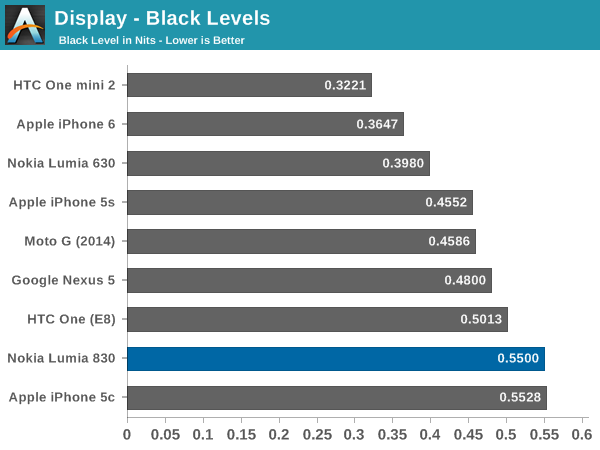
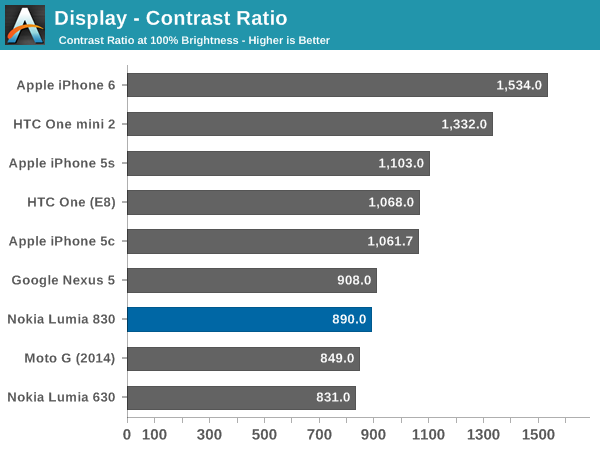
At almost 500 nits, the Lumia 830 is plenty bright for most situations. However the relatively poor black levels result in a contrast ratio that is not spectacular. The black levels are the one thing I noticed while using this device especially when my daily phone is OLED.
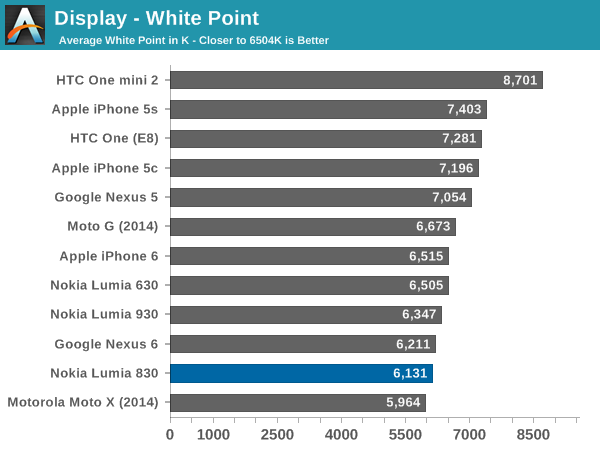

The white point on the Lumia 830 is a bit under what we would be looking for, however you can see from the Calman results that the green starts to shift quite high as the white level rises. That combined with the blue falling away results in a less than amazing 5.207 grayscale average dE2000 score. It is not a great result especially when compared to the Lumia 630, which was one of the better scoring phone displays we have tested and is in a much cheaper device from the same manufacturer. It is clear that the Lumia line has not yet taken display calibration seriously.
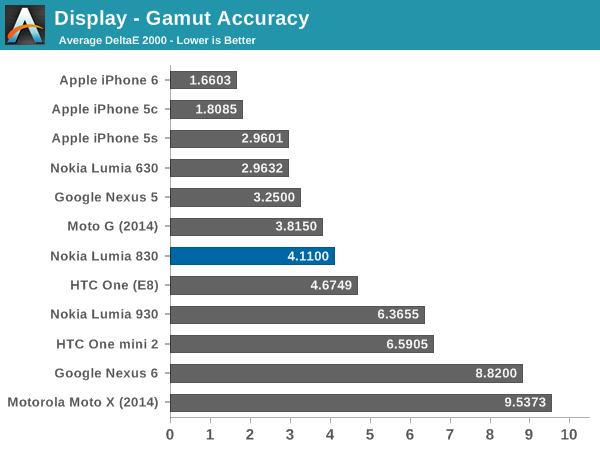
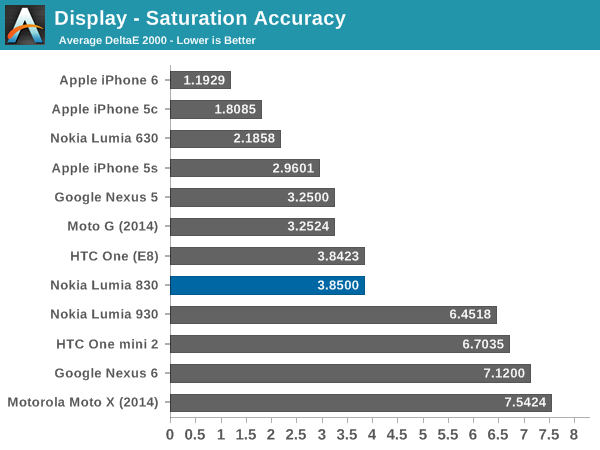
The saturation sweeps are a bit better than grayscale. We are looking for values under 3, and the Lumia 830 is not too far off this mark. At 3.85, it is still quite a way from the Lumia 630’s 2.18 though.
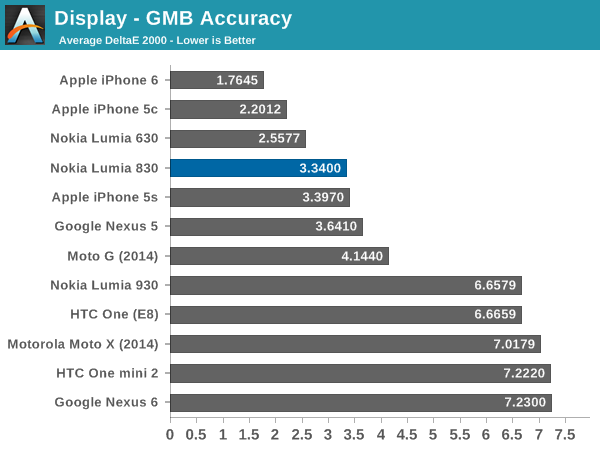
The Lumia 830 does fairly well in the GMB checker, despite the poor grayscale. It comes in with a good, but not great result, and still falls short of the Lumia 630.
The Lumia 830 does support the recently added options for an advanced color profile, which will allow a user to adjust the display to one of three presets (Standard, Vivid, Cool) or to choose Advanced and manually adjust color temperature, tint, and saturation. We are still without a mobile operating system with full color profile support, but this is a good step in the right direction.
Using these settings, you should be able to pull the green down a bit in order to correct the display. The disappointment is that the display is not correct when it leaves the factory though.
The Lumia 830 ends up with a middle of the road LCD. Black levels are not the greatest, but the overall accuracy of the display is not so far off the charts as to be unusable either. The white point is a bit low, but better than some displays which come from the factor with a huge blue shift.


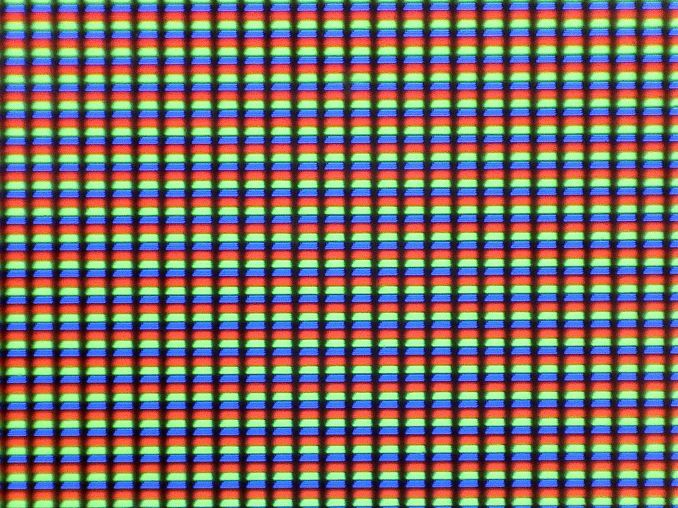



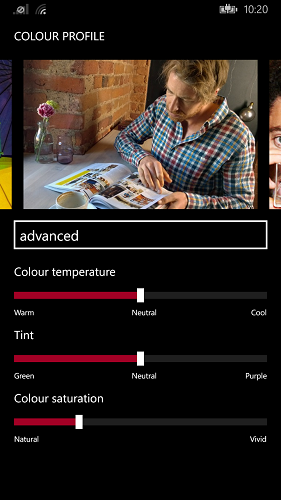








98 Comments
View All Comments
kspirit - Tuesday, November 25, 2014 - link
I was hoping to get this as an upgrade to my 925, but it offers nothing excellent. The camera and display are underwhelming. This is still an incredibly good-looking phone though, but nothing exceptional besides that. The cutbacks Microsoft is making on Lumias are pretty obvious... They're kind of ruining the solid hardware reputation of Nokia.BMNify - Tuesday, November 25, 2014 - link
what cutbacks? Why were you hoping to upgrade from 925 to an 830?? you should be looking at 930 or 1520 for proper upgrade not downgrade to 8xx series and then complain about cutbacks.retrospooty - Tuesday, November 25, 2014 - link
LOL... It's like saying the 2014 Civic isn't as feature rich as the 2013 Accord. Of course not.PubFiction - Tuesday, November 25, 2014 - link
He has a pretty good point, if this phone wants to be a premium phone alternative it needs to have at least something of the major components that would actually be considered premium. It has nothing. Premium phones are 1920x1080 or better, they have 2GB of ram or more, they have snapdragon 800+ chipsets. This phone doesn't have any of that so the reality is it just isn't a premium phone its an average midrange phone.kspirit - Wednesday, November 26, 2014 - link
THIS! Thank you.cheshirster - Friday, November 28, 2014 - link
Average midrange phones do not have what Lumia 830 has.OIS and Qi are not widely presented
Not every flagman has HAAC mics
Metal body is nowhere to be seen under 400$ mark.
Laxaa - Sunday, November 30, 2014 - link
Those are very valid points. HAAC mics are a great feature I wish every phone had. I mean, most of the high-end flagships today(iPhone 6 and Nexus 6 in particular) only captures mono sound. It's kind of funny when companies boast their 4K recording capabilities without any decent sound recording to back it up. Not even stereo(Samsung, Sony and HTC does stereo so it's not all lost)garretelder - Thursday, December 4, 2014 - link
Not one of the top phones (see http://www.topreport.org/phones/ instead) in my opinion.retrospooty - Monday, December 1, 2014 - link
I am not seeing it... It is not a high end model. It's a low end model. Why would the 830 be "premium", it's a low end phone? What he should be looking for is the (assumed) upcoming model replacement for the 925, which is a higher end model - not the 830.Let me put it another way since the car thing didn't seem to work... It's like saying the 2014 Moto G isnt as nice as the 2013 Moto X. - different model families... Get it?
kspirit - Wednesday, November 26, 2014 - link
I thought it was clear...?They eliminated Glance on almost all the current lineup to save on display cost.
They also removed the camera buttons on all phones below the 830.
In a day where cheaper phones have 1080p displays, they still offer a badly calibrated 720p panel, and a camera with a sensor size that is almost an insult to the name of PureView. This doesn't even touch the upper range, despite being marketed as an 'affordable flagship'...